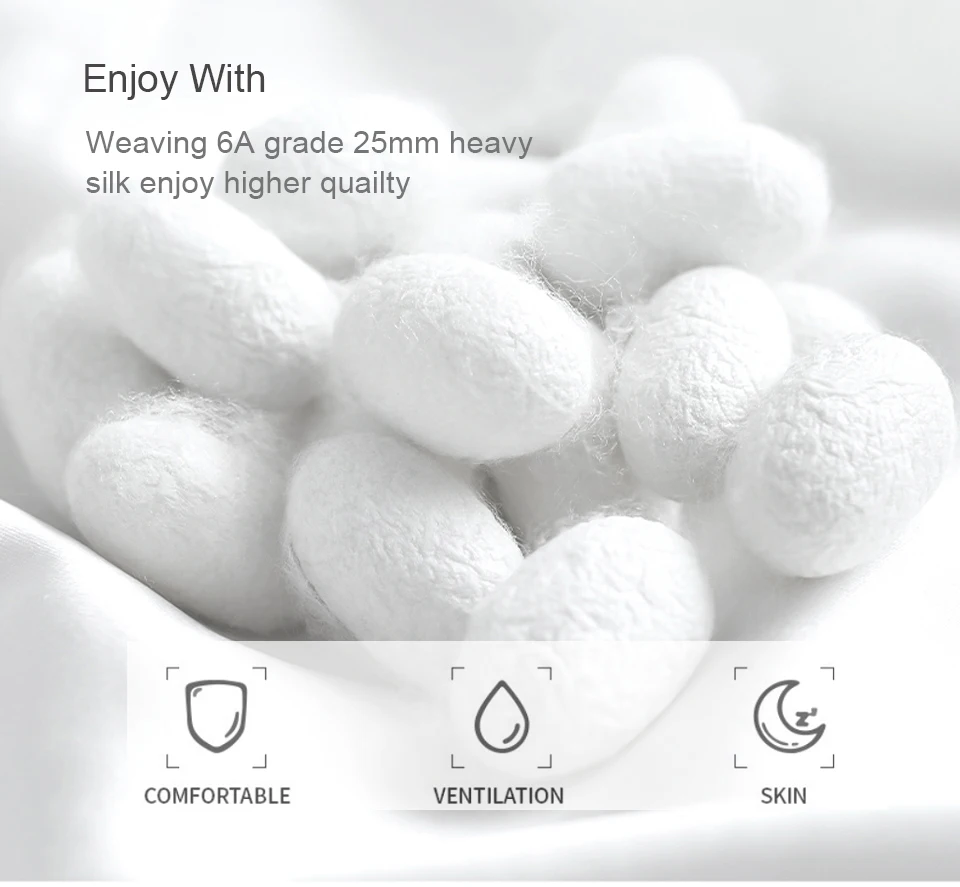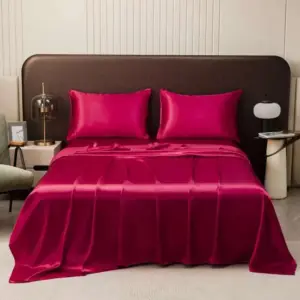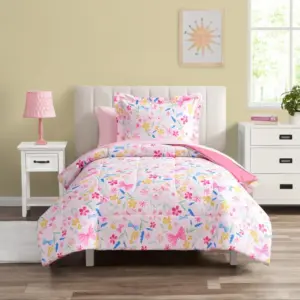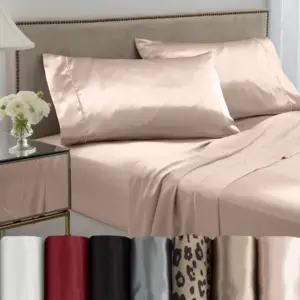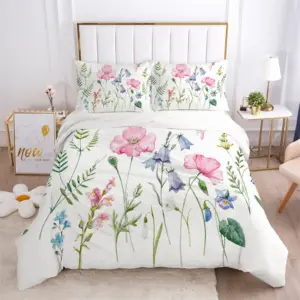Understanding Silk Quality Metrics: Thread Count vs. Momme Weight
When shopping for silk bedding, you might instinctively look for thread count—a familiar quality indicator for cotton sheets. However, thread count is not the primary quality indicator for silk bedding products.
Many consumers make the mistake of applying cotton sheet metrics to silk products because thread count has been heavily marketed as the universal indicator of quality in the bedding industry. This misapplication leads to confusion and potentially poor purchasing decisions when selecting silk items.
Instead of thread count, silk quality is measured primarily by momme weight, a traditional Japanese measurement system that indicates the density and quality of silk fabric. This fundamental difference is crucial to understand when shopping for luxurious silk bedding.
In this article, you’ll learn why thread count doesn’t apply to silk, what momme weight actually measures, and the complete set of quality indicators that will help you make informed silk bedding purchases. Understanding these distinctions will ensure you invest in silk bedding that delivers the luxurious experience you’re seeking.
The amazing benefits of Mulberry silk sheets are directly related to their quality metrics, which differ significantly from cotton. For those seeking a deeper understanding, the complete guide to Mulberry silk bed sheets explores these quality factors in greater detail. When comparing quality indicators, understanding the difference between momme vs thread count in silk is essential for making an informed purchase. When browsing Mulberry silk sheets, paying attention to the correct quality metrics will lead you to a better product.
Why Thread Count is Misleading for Silk Bedding
Thread count and silk simply don’t belong together, and here’s why. Cotton and silk have fundamentally different fiber structures, making thread count an inappropriate measurement for silk quality.
Thread count refers to the number of threads (both horizontal and vertical) woven into one square inch of fabric. This works well for cotton because cotton consists of short, spun fibers that are twisted together to form threads. The more threads that can be woven into a square inch, the denser and generally more durable the fabric becomes.
Silk, however, is composed of long, continuous filaments. A single silkworm filament can be up to 1,000 yards long—vastly different from cotton’s short fibers. These continuous filaments create an inherently smooth surface without requiring a high number of threads.
When manufacturers market silk with thread count numbers, it’s often misleading because:
- Silk’s natural structure already provides smoothness without needing high thread density
- Thread count numbers for silk are often artificially inflated by counting plies rather than actual threads
- The continuous nature of silk filaments means counting individual threads doesn’t reflect quality as it does with cotton
Industry experts consistently confirm that thread count simply isn’t relevant when assessing silk quality. Using this metric for silk is like measuring a car’s quality by how many cupholders it has—it’s looking at the wrong feature entirely.
For more clarity about this common misconception, understanding thread count in silk sheets provides additional context. When shopping for 100% silk sheets, focusing on the right metrics will lead to a much better purchase decision.
Understanding Momme Weight: The True Measure of Silk Quality
Momme weight (pronounced “moh-mee”) is the authentic metric for measuring silk quality. Unlike thread count, momme directly measures the density and weight of silk fabric, providing a reliable indicator of its quality, durability, and feel.
Momme is defined as the weight in pounds of a piece of silk fabric measuring 45 inches wide and 100 yards long. The higher the momme number, the heavier and denser the silk fabric. This measurement directly correlates to how much silk was used in creating the fabric—more silk means more durability, better drape, and greater opacity.
Here’s a breakdown of different momme weight ranges and what they mean for silk products:
| Momme Range | Characteristics | Best Uses |
|---|---|---|
| 6-12 momme | Light, semi-transparent, less durable | Scarves, summer clothing |
| 13-18 momme | Medium weight, good durability, semi-opaque | Clothing, linings, light bedding |
| 19-25 momme | Heavy weight, excellent durability, opaque | Premium bedding, luxury sheets |
| 26-30+ momme | Very heavy, maximum durability, fully opaque | Ultra-luxury bedding, decor items |
For silk bedding, the sweet spot is typically 19-25 momme. This range provides the optimal balance between luxurious feel, durability, and value. Bedding below 19 momme may wear out quickly, while anything above 25 momme might feel unnecessarily heavy and be more expensive without proportional benefits.
The momme weight directly impacts not just the durability but also the drape, feel, and appearance of silk bedding. Higher momme silk has more silk fibers per area, creating a more substantial fabric with better temperature regulation properties.

For comprehensive information about this crucial quality metric, the ultimate guide to momme weight in silk bedding explores all the details you need to know. When shopping for luxury silk bedding sets, look for products in the optimal momme weight range to ensure quality and longevity.
The Impact of Momme Weight on Silk Bedding Performance
Momme weight doesn’t just influence how silk bedding looks—it fundamentally affects how it performs in several important ways:
- Durability and Longevity
- Higher momme silk (19-25) can last for years with proper care
- Lower momme silk (below 16) may develop tears or wear through within months
Higher density means better resistance to friction and regular use
Softness and Drape
- Mid-range momme silk (19-22) offers the perfect balance of softness and body
- Lower momme silk can feel flimsy or insubstantial
Higher momme silk (25+) provides a luxuriously substantial feel with excellent drape
Opacity and Appearance
- 19-25 momme silk is generally opaque enough for bedding
- Lower momme silk may appear translucent or reveal patterns underneath
Higher momme creates a richer visual depth and more lustrous appearance
Temperature Regulation
- Optimal 19-25 momme silk provides the best balance for temperature regulation
- The proper density of silk fibers allows for excellent air circulation while still providing insulation when needed
This creates the famous “cooling in summer, warming in winter” effect
Cost Implications
- Higher momme silk uses more raw material and costs more to produce
- The sweet spot of 19-25 momme offers the best value-to-quality ratio
- Extremely high momme (30+) has diminishing returns for bedding applications
When examining silk flat sheets, you’ll notice these performance differences across various momme weights, with the optimal range providing the best combination of luxury, performance, and value.
Mulberry Silk: The Gold Standard for Bedding
While momme weight measures silk density, the type of silk used is equally important for quality assessment. Mulberry silk stands as the uncontested gold standard for bedding applications.
Mulberry silk comes from Bombyx mori silkworms that feed exclusively on mulberry leaves. This specialized diet produces exceptionally fine, strong, and uniform silk filaments. The resulting fabric features longer, more consistent fibers that create a smoother surface and more durable material than other silk varieties.
The distinctive qualities that make Mulberry silk superior include:
- Exceptionally long, uniform filaments (up to 1,000 yards per cocoon)
- Naturally white color that takes dye beautifully
- Strong yet incredibly fine fibers that create an unmatched smooth texture
- Superior temperature-regulating properties
- Excellent moisture-wicking capabilities
In contrast, other silk types like Tussah (wild silk) have shorter, coarser fibers with varying colors and textures. While these silks have their own unique beauty and uses, they lack the refined uniformity and softness that make Mulberry silk ideal for bedding.
The cultivation process for Mulberry silk is carefully controlled, with silkworms raised in protected environments and fed a strict diet of mulberry leaves. This consistent care results in silk of consistent quality—a crucial factor for luxurious bedding products.
Learning what makes Mulberry silk special reveals why it commands premium prices and delivers superior performance. When shopping for Mulberry silk bedding sets, understanding this distinction helps justify the investment in genuine Mulberry silk products.
Silk Grades Explained: From A to 6A
Beyond momme weight and silk type, grade is another critical quality indicator for silk bedding. The silk grading system ranges from A to 6A, with 6A representing the highest possible quality.
This grading system primarily evaluates:
* Consistency and uniformity of silk threads
* Purity of the silk (absence of impurities)
* Quality of manufacturing process
* Overall fabric refinement
Grade 6A silk represents the pinnacle of quality with these characteristics:
* 100% long-strand Mulberry silk
* Meticulously hand-selected cocoons
* Minimal yarn joining for exceptionally smooth texture
* Completely uniform color and texture
* Maximum durability and longevity
When shopping, it’s important to note that genuine Grade 6A silk commands premium pricing. Products marketed as 6A silk at surprisingly low prices often misrepresent their quality. True high-grade silk feels incredibly smooth, has a subtle luster (not shiny like satin), and displays perfect uniformity in weave and color.
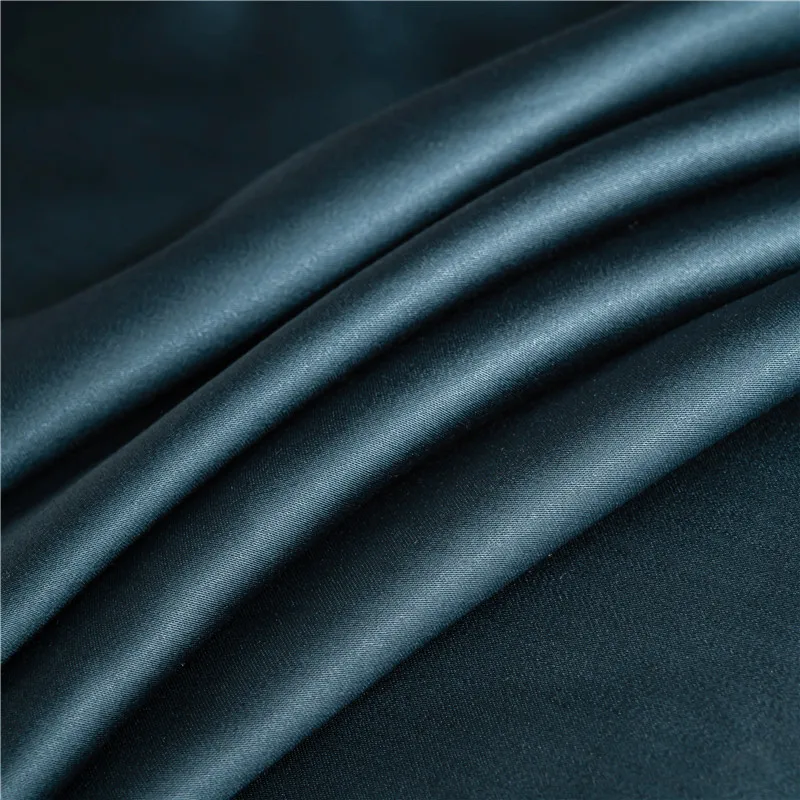
Lower grades of silk (A through 4A) may contain shorter strands, more joins, slight irregularities, or minor imperfections. While still beautiful, they won’t offer the same luxurious experience or longevity as higher grades.
Understanding the best type of silk for bedding includes recognizing these important grade distinctions. When browsing silk sheets, look for clear information about both momme weight and grade to ensure you’re getting genuine quality.
The Importance of Weave in Silk Bedding
The weaving technique used in silk fabric creation significantly impacts its feel, appearance, and performance. The weave structure determines how silk threads interlace, creating distinct textures and properties.
For bedding, the Charmeuse weave reigns supreme. This sophisticated weaving technique creates fabric with:
* A lustrous, smooth front face
* A slightly matte back side
* Exceptional softness and drape
* Good durability for daily use
* Ideal temperature-regulating properties
The Charmeuse weave’s unique structure features a satin weave on the front (where warp threads float over several weft threads) combined with a crepe back. This creates the signature two-sided texture that makes silk bedding so distinctive.
Other silk weaves include:
* Habotai (China Silk): Lightweight with a basic plain weave, less durable for bedding
* Crepe de Chine: Slightly textured with a pebbly feel, less smooth than Charmeuse
* Silk Twill: Diagonal weave pattern, very durable but less lustrous
* Satin: Very shiny but often made with synthetic fibers, not true silk
The Charmeuse weave specifically enhances silk’s natural benefits for skin and hair, allowing the fabric to glide smoothly against these surfaces while maintaining breathability. This makes it particularly beneficial for pillowcases and sheets that directly contact your body.
When shopping for silk bedding sets, the combination of high-quality Mulberry silk in a Charmeuse weave provides the optimal balance of luxury, durability, and performance benefits.
Quality Certifications to Look For When Buying Silk Bedding
Beyond physical characteristics, quality certifications provide additional assurance about silk bedding’s safety and production standards. These third-party verifications offer peace of mind about what you’re bringing into your bedroom.
The OEKO-TEX Standard 100 certification is particularly important for silk bedding. This globally recognized certification ensures textiles have been tested for harmful substances and are safe for human use. For silk products, OEKO-TEX certification verifies the absence of:
* Harmful dyes or colorants
* Formaldehyde
* Pesticides
* Heavy metals
* Other potentially harmful chemicals
This certification is especially valuable for silk bedding because the fabric directly contacts your skin for extended periods. For people with sensitive skin or allergies, OEKO-TEX certified silk significantly reduces irritation risks.
Other valuable certifications include:
* Global Organic Textile Standard (GOTS) for organically produced silk
* Silk Mark (for products made with 100% natural silk)
* Fair Trade certifications (for ethically produced products)
These certifications address not just personal health concerns but also broader environmental and ethical considerations in silk production. They provide additional dimensions of quality beyond the physical characteristics of the fabric itself.
For those with specific skin concerns, Mulberry silk sheets for sensitive skin offer exceptional benefits, especially when backed by appropriate safety certifications.
Construction Details That Signal Quality Silk Bedding
Even the finest silk fabric can be diminished by poor construction. Quality silk bedding displays superior craftsmanship in several key areas:
- Seam Construction
- French seams or flat-felled seams that encase raw edges
- Even, tight stitching with no loose threads or puckering
Minimal seams in sleep areas to reduce pressure points
Pillowcase Features
- Hidden zipper or envelope closures that prevent slipping
- Reinforced corners to prevent tearing
Double-stitched edges for durability
Sheet Construction
- Deep pocket designs that stay securely on mattresses
- Reinforced corner elastics in fitted sheets
Properly aligned patterns if the fabric is patterned
Edge Finishing
- Clean, even hemming with consistent width
- Mitered corners on flat sheets
No visible raw edges anywhere in the product
Overall Craftsmanship
- Smooth, even fabric with no snags or pulls
- Consistent color throughout the product
- Proper sizing according to specifications
These construction details significantly impact both the immediate luxury experience and the long-term durability of silk bedding. Well-constructed silk bedding will maintain its beauty and performance through years of use and washing when properly cared for.
Examining silk pillowcases reveals how these construction details enhance both function and luxury in quality silk products.
The Benefits of Investing in High-Quality Silk Bedding
Understanding quality metrics is important, but what tangible benefits do these quality indicators deliver? High-quality silk bedding offers several significant advantages that justify the investment:
Skin and Hair Benefits
Quality silk contains natural proteins and amino acids similar to those in human skin. The smooth surface creates minimal friction, preventing sleep creases and reducing hair breakage. The fabric’s moisture-wicking properties help maintain optimal skin hydration throughout the night.
Superior Temperature Regulation
High-quality silk with proper momme weight creates the ideal microclimate for sleep. It naturally adjusts to body temperature, cooling you in warm conditions and providing insulation when it’s cool. This temperature-regulating property helps maintain consistent comfort throughout the night.
Hypoallergenic Properties
Premium silk naturally resists dust mites, mold, and mildew. The tight weave and protein structure of quality silk create an inhospitable environment for common allergens. This makes silk bedding an excellent choice for allergy sufferers and those with sensitive skin.
Unmatched Comfort Experience
The combination of silk’s natural properties with quality construction creates an unparalleled sleep experience. The fabric’s weight, drape, and smooth texture against skin deliver a unique luxury that synthetic “silk-like” fabrics simply cannot match.
Long-Term Value
While quality silk bedding represents a significant initial investment, its exceptional durability translates to better value over time. Premium silk bedding often lasts 5-10 years with proper care—significantly longer than lower-quality alternatives that may need replacement after just a year or two.
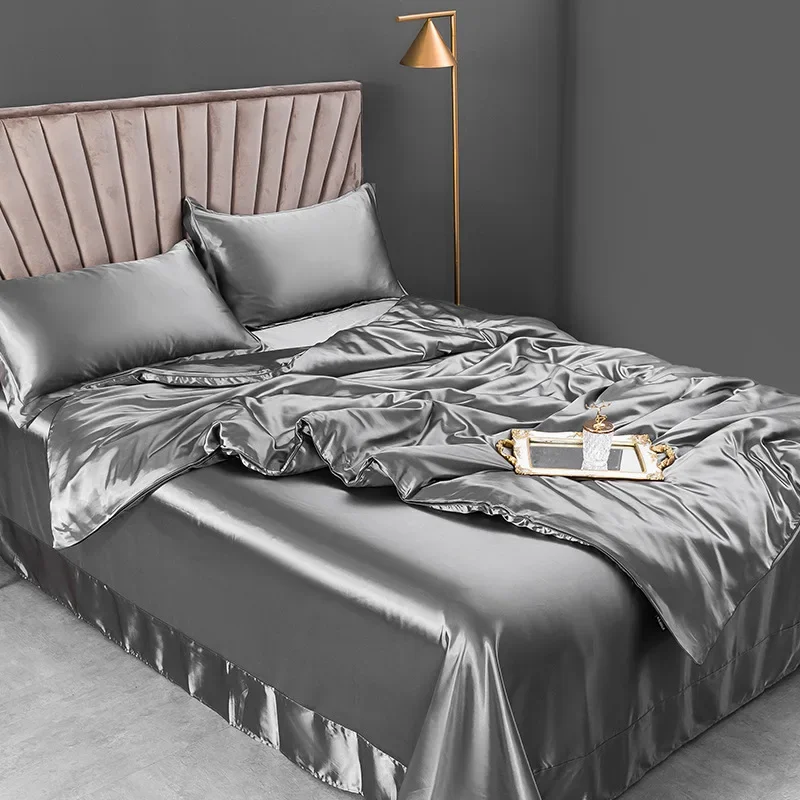
The advantages of sleeping on Mulberry silk are directly tied to these quality characteristics. For those seeking temperature management benefits, cooling silk sheets with the proper quality metrics provide optimal performance.
Full-size Silk Sheets, King Size Silk Sheets, Queen Size Silk Sheets, Twin Size Silk Sheets, Washable Silk Sheets
Price range: $95.95 through $178.37 Select options This product has multiple variants. The options may be chosen on the product page100% Silk Sheets, Green Silk Sheets, King Size Silk Bedding Set, Mulberry Silk Bedding Sets, Queen Size Silk Bedding Set
Price range: $1,246.21 through $1,615.22 Select options This product has multiple variants. The options may be chosen on the product pagePink Silk Sheets, Twin Size Silk Sheets
$171.80 Select options This product has multiple variants. The options may be chosen on the product pageFull-size Silk Sheets, Pink Silk Sheets
$136.31 Select options This product has multiple variants. The options may be chosen on the product pageFull Silk Bedding Set, King Size Silk Bedding Set
Price range: $120.99 through $190.49 Select options This product has multiple variants. The options may be chosen on the product pageGrey Silk Sheets, Silk Sheet and Pillowcase Set
Price range: $88.20 through $146.64 Select options This product has multiple variants. The options may be chosen on the product page
How to Choose the Best Silk Bedding: A Buyer’s Guide
Armed with understanding about true silk quality indicators, use this step-by-step guide to select the best silk bedding for your needs:
Verify Momme Weight
Look for silk bedding with 19-25 momme weight for the optimal balance of durability, feel, and value. This range provides sufficient weight for proper drape while maintaining breathability.Confirm Silk Type
Choose 100% Mulberry silk for bedding applications. This offers the finest, most uniform filaments with superior softness and durability compared to other silk varieties.Check Grade Classification
Seek out Grade 6A silk when possible, particularly for pillowcases that directly contact your face. For budget considerations, Grade 5A provides excellent quality at a slightly lower price point.Examine Construction Quality
Look for French seams, reinforced edges, and consistent stitching. Quality construction significantly impacts durability and comfort.Look for Proper Certifications
Prioritize products with OEKO-TEX certification to ensure your bedding is free from harmful substances. This is particularly important for direct-contact items like sheets and pillowcases.Verify Authentic Silk
To test if silk is genuine, rub the fabric between your fingers—real silk warms quickly. Small threads from real silk will curl when burned and smell like burning hair, while synthetic alternatives melt.Consider Care Requirements
Quality silk typically requires gentle washing with pH-balanced detergent. Consider whether you’re willing to follow proper care guidelines to maintain your investment.Evaluate Color Consistency
High-quality silk displays even coloration throughout. Examine the fabric in good lighting for any inconsistencies that might indicate lower quality dyeing processes.
Learning to choose silk sheets beyond thread count empowers you to make better purchasing decisions. Many consumers find that queen size silk sheets offer the perfect balance of space and luxury for standard bedrooms.
Common Misconceptions About Silk Bedding
As we’ve explored throughout this article, several misconceptions surround silk bedding. Let’s address these myths directly:
Myth: Thread Count Determines Silk Quality
Fact: Thread count is irrelevant for silk bedding. Momme weight, silk type, grade, and weave are the true indicators of quality. A 1,000 thread count silk sheet is likely using misleading marketing rather than offering superior quality.
Myth: Silk Bedding Is Too Delicate for Regular Use
Fact: Quality silk bedding with appropriate momme weight (19-25) is surprisingly durable. While it requires proper care, high-quality silk can last for many years with regular use. Modern silk bedding is designed for practical, everyday luxury—not just special occasions.
Myth: Silk Care Is Extremely Complicated
Fact: While silk does require more careful handling than cotton, caring for silk bedding is simpler than many believe. Most quality silk can be hand-washed or machine-washed on gentle cycles with mild detergent. Follow the manufacturer’s care instructions for best results.
Myth: Silk Bedding Is Unnecessarily Expensive
Fact: Quality silk represents value when evaluated properly. When considering cost-per-use over its lifetime and the numerous benefits it provides, silk bedding often proves more economical than repeatedly replacing lower-quality alternatives. Additionally, the sleep quality improvements and skin/hair benefits add value beyond the fabric itself.
Understanding these realities helps consumers make informed decisions when shopping for silk bedding. The difference between thread count and silk quality demonstrates why focusing on the right metrics leads to better purchasing decisions.
At Sanctuary Soft, we believe that understanding these quality factors allows customers to make truly informed decisions when investing in luxury bedding. By focusing on the metrics that actually matter—momme weight, silk type, grade, and construction—you can select silk bedding that delivers both immediate luxury and long-term value.

